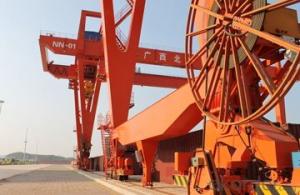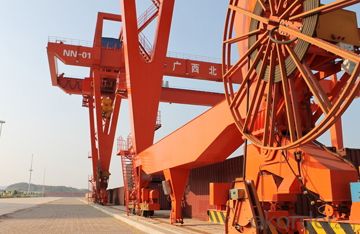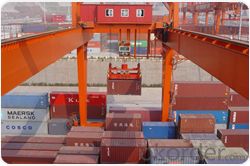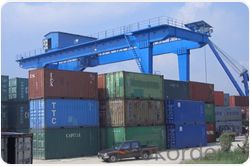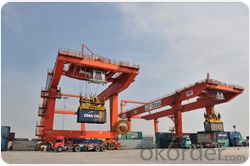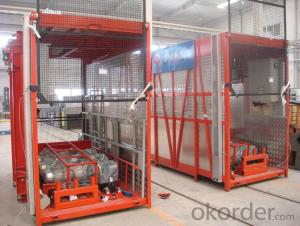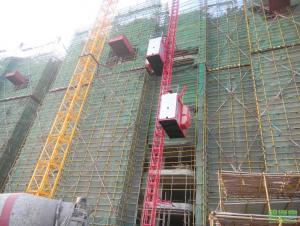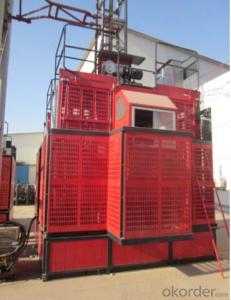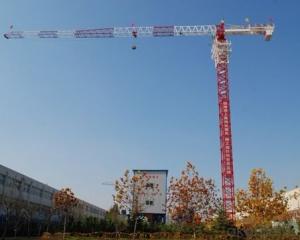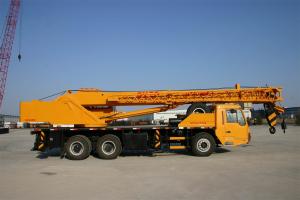Rail Mounted Container Crane to lift 20'40' ISO standard container
- Loading Port:
- Shanghai
- Payment Terms:
- TT OR LC
- Min Order Qty:
- 1 unit
- Supply Capability:
- 20 unit/month
OKorder Service Pledge
OKorder Financial Service
You Might Also Like
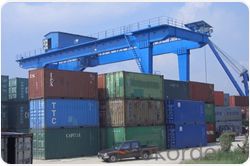
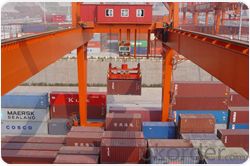
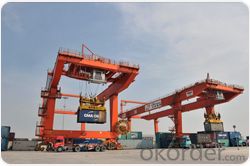
Rail-mounted container gantry cranes(RMG) is a specialized yard container handling machine. It can travel on rail by means of the yard power, and lift an stack containers in the yard area with the equipment of the 20' or 40' telescopic spreader (or twin-lift spreader if needed).Compared with the rubber-tyre gantry crane (RTG), the RMG has the advantage of being driven by electrical power, clean, bigger lifting capacity, an high gantry traveling speed with cargo. The RGM consists of lifting mechanism, trolley traversing mechanism, gantry mechanism and sway-dampening mechanism.
The lifting, gantry and trolley mechanisms are mostly equipped with AC frequency conversion control system. Normally the lifting mechanism is of the single drum type.It can also be designed to be double drum type if needed. Our corporation can design and manufacture according to demands of user.
Working condition:
working temperature: -25-40 °C(can be specially designed to -40°C-+40°C)
Lifting capacity under spreader is 30.5t 35.0t 40.5t and 50.0t;
Working duty: A6- A8.
Power source: 380V 50Hz 3Phase. And we can design as your demands.
The altitude height of site is ought to be less than 2000M.
Flammable, explosive and corrosive gas is forbidden in the work environment.
The crane is forbidden to lift fuse and blend deleterious article and flammable explosive article.
Safety:
Overload protection.
Main lifting motor with thermal protection.
Rubber buffers.
Protective earthing.
Anti sway electric system
Crane switch and travel end switch.
Emergency switch can stop all movement when any dangerous happened.
Sub-assemblies characteristic are tested before assembly.
All cranes must be pre-assembled and tested before leaving factory and offer the certification of test.
Features:
Full electric drive technology. Energy saving and environmental protection. Reduce operation and maintenance costs.
Frequency conversion. Accurate locating container and improving working efficiency.
PLC control, which can meet the automation demand of modern container yard.
Tailored designs. Our product will be designed to your container yard most suitably.
Technical Data:
Capacity of Spreader | t | 30.5 | 35 | 40.5 | 50 | ||
Working Duty | A6-A8 | A6-A8 | A6-A8 | A6-A8 | |||
Span(m) | S | 35 | 35 | 35 | 35 | ||
Base(m) | B | 16 | 16 | 16 | 16 | ||
Lifting Height(m) | H | 15.4 | 15.4 | 18.2 | 18.2 | ||
Speed | Hoisting | With Full Load | m/min | 12 | 12 | 18 | 18 |
Only with Spreader | 24 | 24 | 36 | 36 | |||
Travese | 60 | 60 | 70 | 70 | |||
Traveling | 45 | 45 | 45 | 45 | |||
Total Power | kw | ~200 | ~230 | ~255 | ~300 | ||
Max.working Load of Wheel | kn | 260 | 260 | 280 | 300 | ||
Crane Rail | P50 | P50 | P50 | QU80 | |||
Power Supply | 3-phase AC 380v 50Hz or as your demand | ||||||
- Q: This question asks about the criteria for determining when a building hoist has reached the end of its useful life and should be replaced.
- <p>The lifespan of a building hoist is determined by several factors including its design, materials, usage, maintenance, and compliance with safety standards. Regular inspections and maintenance are crucial to assess the hoist's condition. A hoist should be replaced when it shows significant wear, has been in service beyond the manufacturer's recommended lifespan, or fails to meet safety standards. Additionally, any hoist that has been involved in an accident or has undergone major repairs may need to be replaced to ensure safety. Consulting the manufacturer's guidelines and local regulations can provide specific information on when a hoist should be retired.</p>
- Q: This question asks about the regular maintenance tasks needed to keep hydraulic pumps in building hoists functioning properly.
- <p>Maintenance requirements for hydraulic pumps in building hoists include regular inspection of the pump for leaks, wear, and proper lubrication. It's crucial to check the hydraulic oil level and quality, ensuring it's clean and at the correct level. The oil should be changed periodically as per the manufacturer's recommendations. Inspect the pump for any unusual noises or vibrations which could indicate wear or damage. Regularly clean the filter to prevent blockages and ensure efficient operation. Additionally, check the pump's pressure and flow rate to confirm it's operating within the specified parameters. Following the manufacturer's maintenance schedule and guidelines is essential to prolong the life of the hydraulic pump and ensure the safety and efficiency of the building hoist.</p>
- Q: Is it possible to fix a building hoist or substitute it with alternative lifting machinery?
- <p>Yes, a building hoist can be repaired if the damage is not severe. If repair is not feasible or cost-effective, it can be replaced by other types of lifting equipment. There are various alternatives available, such as cranes, forklifts, and material hoists, each with its own advantages and suitable for different scenarios. The choice depends on factors like the weight of the load, the height of the building, and the specific requirements of the construction project. It's essential to consider safety, efficiency, and compatibility with the existing infrastructure when making such decisions.</p>
- Q: Is it possible for one operator to manage several lifting devices, including a Building Hoist, at the same time?
- <p>Yes, it is possible for a single operator to handle the operation of multiple lifting devices, including Building Hoists, depending on the specific equipment and safety regulations. Modern building hoists are often designed with advanced controls that allow for efficient management of multiple units. However, this must be done in compliance with local laws and safety standards, which may require additional training or certifications for the operator. It's crucial to ensure that the operator has the necessary skills and that the operation does not compromise safety.</p>
- Q: This question asks for a comparison of various types of electric building hoists, highlighting their unique features and differences.
- <p>Electric building hoists come in various types, each designed for specific applications. The main differences lie in their capacity, lifting speed, control systems, and construction. For instance, worm gear hoists are compact and offer precise control, suitable for light to medium-duty applications. Chain hoists are versatile with higher speeds and are ideal for general lifting tasks. Electric wire rope hoists are powerful and designed for heavy-duty lifting, often used in construction and industrial settings. Variable frequency drives in hoists allow for speed control, enhancing safety and efficiency. Each type has its operational advantages and limitations, making the choice dependent on the specific lifting requirements and environmental conditions.</p>
- Q: This question inquires about the cost of a hydraulic building hoist.
- <p>The cost of a hydraulic building hoist can vary significantly depending on factors such as capacity, brand, features, and new or used condition. Prices typically range from a few thousand dollars for smaller, basic models to tens of thousands for larger, more advanced units. For a precise quote, it's best to contact manufacturers or suppliers with specific requirements, as costs can fluctuate based on the model and market conditions. It's also advisable to consider ongoing maintenance and operational costs when budgeting for a hydraulic building hoist.</p>
- Q: This question asks for safety guidelines and procedures to be followed when operating a building hoist.
- <p>To use a building hoist safely, follow these guidelines: Ensure the hoist is regularly inspected and maintained by qualified personnel. Never exceed the hoist's load capacity. Keep the hoist and its surroundings clean and free from debris. Always use safety hooks and never leave the hoist unattended when in use. Ensure all safety features, such as limit switches and emergency stop buttons, are functioning correctly. Train operators on the proper use of the hoist and adhere to all manufacturer's instructions. Never use a hoist if it shows signs of damage or malfunction. Always wear appropriate personal protective equipment (PPE) when operating a hoist.</p>
- Q: This question asks for the safety precautions that should be taken when operating electric-hydraulic construction hoists.
- <p>Safety measures for using electric-hydraulic building hoists include regular maintenance and inspection to ensure all components are in good working order. Operators must be trained and certified, following all safety protocols. Never exceed the hoist's load capacity. Ensure that safety hooks and chains are in place and secure. Keep the hoist area clear of debris and unauthorized personnel. Use proper lifting techniques and avoid sudden starts or stops. Always inspect the load before lifting to ensure it is stable and secure. Emergency stop switches should be easily accessible. Ensure that all safety guards are in place and functioning properly. Adhere to all local regulations and manufacturer's guidelines.</p>
- Q: This question asks for the steps or methods to fix a malfunctioning building hoist.
- <p>Repairing a broken building hoist requires a systematic approach. First, ensure the hoist is powered off and disconnected from any power source to ensure safety. Identify the specific issue by conducting a visual inspection and possibly consulting the hoist's manual or a professional. Common repairs include fixing mechanical parts like gears, chains, or cables, or addressing electrical issues like faulty wiring or motor problems. If the hoist's control system is malfunctioning, it may require recalibration or replacement of components. In some cases, worn or damaged parts need to be replaced. Always follow the manufacturer's guidelines and safety protocols. For complex repairs, it's best to consult with a professional hoist technician to avoid further damage or safety hazards.</p>
- Q: This question asks if construction equipment like building hoists can be damaged due to long-term use or incorrect handling.
- <p>Yes, lifting equipment, including Building Hoists, can be damaged by prolonged use or improper operation. Over time, constant use can lead to wear and tear, affecting the equipment's structural integrity. Improper operation, such as overloading or misuse, can cause immediate damage or reduce the lifespan of the equipment. Regular maintenance and adherence to safety guidelines are essential to minimize damage and ensure the longevity of lifting equipment.</p>
Send your message to us
Rail Mounted Container Crane to lift 20'40' ISO standard container
- Loading Port:
- Shanghai
- Payment Terms:
- TT OR LC
- Min Order Qty:
- 1 unit
- Supply Capability:
- 20 unit/month
OKorder Service Pledge
OKorder Financial Service
Similar products
Hot products
Hot Searches
Related keywords
